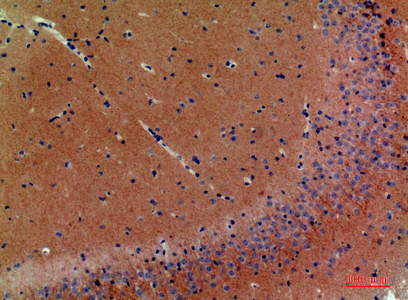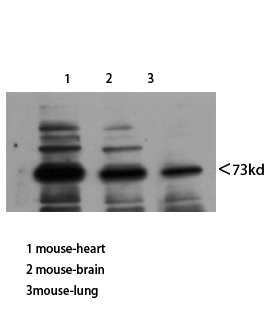Neuregulin-3 Polyclonal Antibody
- Catalog No.:YT5648
- Applications:WB;IHC;IF;ELISA
- Reactivity:Human;Mouse
- Target:
- Neuregulin-3
- Fields:
- >>ErbB signaling pathway;>>Amyotrophic lateral sclerosis
- Gene Name:
- NRG3
- Protein Name:
- Pro-neuregulin-3 membrane-bound isoform
- Human Gene Id:
- 10718
- Human Swiss Prot No:
- P56975
- Mouse Gene Id:
- 18183
- Mouse Swiss Prot No:
- O35181
- Immunogen:
- The antiserum was produced against synthesized peptide derived from the Internal region of human NRG3. AA range:311-360
- Specificity:
- Neuregulin-3 Polyclonal Antibody detects endogenous levels of Neuregulin-3 protein.
- Formulation:
- Liquid in PBS containing 50% glycerol, 0.5% BSA and 0.02% sodium azide.
- Source:
- Polyclonal, Rabbit,IgG
- Dilution:
- WB 1:500 - 1:2000. IHC: 1:100-1:300. ELISA: 1:10000.. IF 1:50-200
- Purification:
- The antibody was affinity-purified from rabbit antiserum by affinity-chromatography using epitope-specific immunogen.
- Concentration:
- 1 mg/ml
- Storage Stability:
- -15°C to -25°C/1 year(Do not lower than -25°C)
- Other Name:
- NRG3;Pro-neuregulin-3, membrane-bound isoform;Pro-NRG3
- Observed Band(KD):
- 80kD
- Background:
- This gene is a member of the neuregulin gene family. This gene family encodes ligands for the transmembrane tyrosine kinase receptors ERBB3 and ERBB4 - members of the epidermal growth factor receptor family. Ligand binding activates intracellular signaling cascades and the induction of cellular responses including proliferation, migration, differentiation, and survival or apoptosis. This gene encodes neuregulin 3 (NRG3). NRG3 has been shown to activate the tyrosine phosphorylation of its cognate receptor, ERBB4, and is thought to influence neuroblast proliferation, migration and differentiation by signalling through ERBB4. NRG3 also promotes mammary differentiation during embryogenesis. Linkage studies have implicated this gene as a susceptibility locus for schizophrenia and schizoaffective disorder. Alternative splicing results in multiple transcript variants encoding distinct isoforms. Additional transcri
- Function:
- developmental stage:Isoform 3 is expressed in fetal brain but not in other fetal tissues.,domain:ERBB receptor binding is elicited entirely by the EGF-like domain.,domain:The cytoplasmic domain may be involved in the regulation of trafficking and proteolytic processing. Regulation of the proteolytic processing involves initial intracellular domain dimerization.,function:Direct ligand for the ERBB4 tyrosine kinase receptor. Binding results in ligand-stimulated tyrosine phosphorylation and activation of the receptor. Does not bind to the EGF receptor, ERBB2 or ERBB3 receptors. May be a survival factor for oligodendrocytes.,PTM:Extensive glycosylation precedes the proteolytic cleavage (By similarity). Isoform 3 is glycosylated.,PTM:Proteolytic cleavage close to the plasma membrane on the external face leads to the release of the soluble growth factor form.,similarity:Belongs to the neuregul
- Subcellular Location:
- [Pro-neuregulin-3, membrane-bound isoform]: Cell membrane ; Single-pass type I membrane protein . Does not seem to be active. .; [Neuregulin-3]: Secreted .; [Isoform 3]: Cell membrane; Single-pass type I membrane protein. Isoform 3 is also proteolytically released as a soluble form.
- Expression:
- Highly expressed in most regions of the brain with the exception of corpus callosum. Expressed at lower level in testis. Not detected in heart, placenta, lung, liver, skeletal muscle, kidney, pancreas, spleen, thymus, prostate, ovary, small intestine, colon and peripheral blood leukocytes.
- June 19-2018
- WESTERN IMMUNOBLOTTING PROTOCOL
- June 19-2018
- IMMUNOHISTOCHEMISTRY-PARAFFIN PROTOCOL
- June 19-2018
- IMMUNOFLUORESCENCE PROTOCOL
- September 08-2020
- FLOW-CYTOMEYRT-PROTOCOL
- May 20-2022
- Cell-Based ELISA│解您多样本WB检测之困扰
- July 13-2018
- CELL-BASED-ELISA-PROTOCOL-FOR-ACETYL-PROTEIN
- July 13-2018
- CELL-BASED-ELISA-PROTOCOL-FOR-PHOSPHO-PROTEIN
- July 13-2018
- Antibody-FAQs
- Products Images

- Western Blot analysis of mouse brain, K562 cells using Neuregulin-3 Polyclonal Antibody. Antibody was diluted at 1:1000. Secondary antibody(catalog#:RS0002) was diluted at 1:20000
.jpg)
- Western Blot analysis of MOUSE-BRAIN cells using Neuregulin-3 Polyclonal Antibody diluted at 1:1000. Secondary antibody(catalog#:RS0002) was diluted at 1:20000

- Immunohistochemical analysis of paraffin-embedded mouse-brain, antibody was diluted at 1:200

- Western Blot analysis of mouse-heart mouse-brain mouse-lung using Neuregulin-3 Polyclonal Antibody diluted at 1:800. Secondary antibody(catalog#:RS0002) was diluted at 1:20000



